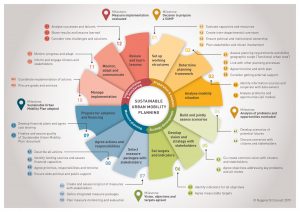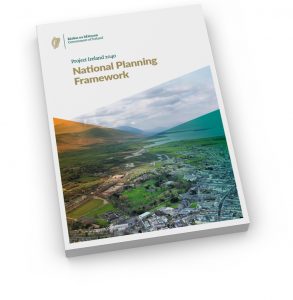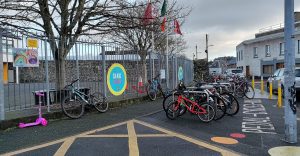The December 2015 Climate Conference in Paris (COP21) set as its target the reduction of greenhouse gas emissions by 20% between 2021 and 2030 across the European Union. This target was increased to 30% in the Glasgow Climate Pact at COP26 in November 2021. The transport sector roughly accounts for approximately one-quarter of the current level of emissions. Attaining these targets requires a policy shift across the European Union towards a more sustainable transport model.
The European Commission has issued policy documents on the move towards sustainable mobility including A Concept for Sustainable Urban Mobility Plans (Commission of the European Communities, 2013). This document included the introduction of Sustainable Urban Mobility Plans (SUMP) to deliver on a more sustainable transport model. The SUMP approach is a departure from the traditional transport planning model in many ways including:
- more public involvement in the process
- more cooperation across local authority sectors
- more cooperation across different local authorities
- taking a broader view of the transport issues to include planning, development, environment, health, social policy etc.
- monitoring of objectives and targets to ensure delivery
- creating a sustainable vision for a city or town.

The concept is supported by guidelines (https://ec.europa.eu/research/participants/documents/downloadPublic?documentIds=080166e5c8774a17&appId=PPGMS) and learning resources (https://www.eltis.org/) to deliver on quality. While these resources draw from the experience of cities who have prepared these plans (https://civitas.eu/), there is an understanding that one size does not fit all, and that each city has different dynamics acting that requires individualisation of the mobility plan.
European countries have taken different approaches to the preparation of these plans. Some have embraced the concept completely; some have adapted their existing plans and procedures to follow SUMP principles and some have not implemented the policy at all. The SUMP process considers the diverse nature of cities across Europe and enables each to prepare a unique plan to deal with their transport problems.
The SUMP concept has never been implemented fully in Ireland. Ireland brings a unique set of circumstances that complicates the delivery of such plans, including inter alia:
- A dispersed population
- Few large cities and many small towns
- Historic reliance on cars for commuting
- Limited public transport provision outside of the major cities
- A road infrastructure deficit
- Many income streams that fund single elements of the mobility issue

Project Ireland 2040 – National Planning Framework (Department of Housing, Planning and Local Government, 2018) has for the first time introduced SUMP principles to an Irish national planning document. It refers to a sustainable policy that will be implemented by Regional Spatial and Economic Strategies. Recent Government Allocations have shown considerable backing for the implementation of these strategies and in particular in the promotion of Active Travel. The Irish case is interesting in so far as there are a number of long-standing policies such as Smarter Travel (Department of Transport, 2009a), Active Travel Towns (Department of Transport Tourism and Sport, 2012), the National Cycle Manual (Department of Transport, 2009b) and the Design Manual for Urban Roads and Streets (Department of Transport Tourism and Sport and Department of Environment Community and Local Government, 2013) that all contain elements that would fit neatly within a SUMP. Local authorities produce development plans which address mobility but they tend not to be very specific in their objectives. While many of these policies have been updated in recent years, without a centralised government strategy, however, it is unlikely that there would be any paradigm shift to sustainable transport. Local Councils rely heavily on the central government for mobility and transport funding. This paradigm shift is happening. Local Councils are now setting up Active Travel Teams to deliver such schemes and this is indeed an exciting time for sustainable transport in Ireland.
The big fear in this Active Travel renaissance is that it turns out to be another short term strategy looking at a single element of the transport and mobility issue. The Sustainable Urban Mobility Plan model has proved successful across Europe because it takes a holistic view of the transportation issue. SUMPs incorporate all modes of transport and aim for balanced and integrated development. The concept of multimodal mobility changes the view of the simple choice between either public or private or motorised or non-motorised transport modes. It also embraces the smart technologies available for car-sharing schemes, traffic information systems, smart technology for traffic lights, park and ride facilities, car park management etc. and it gives the opportunity to encompass all the funding streams from central government to a single focussed plan to address all the transportation issues of individual cities and towns.

At TOBIN Consulting Engineers, we are at the frontline of the Active Travel Renaissance as we deliver sustainable transport projects from Waterville to Glencolumcille and Athboy to Oranmore and many more in between. We are also following SUMP principles in our collaboration in several public realm projects with multi-disciplinary teams looking at a more holistic approach to the delivery of sustainable transport solutions.



